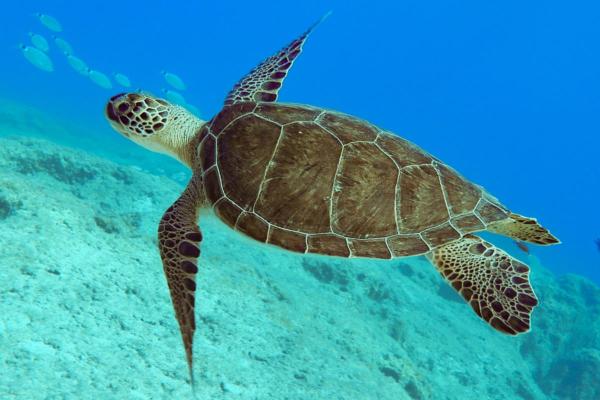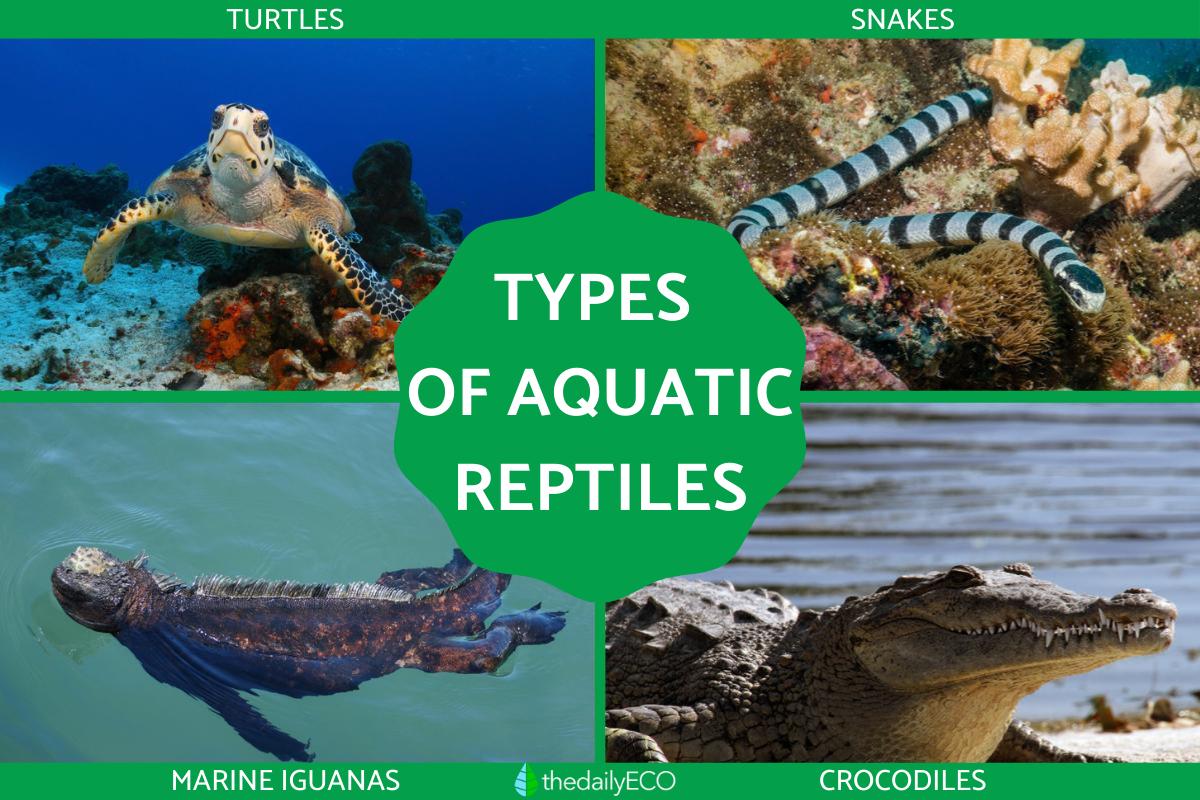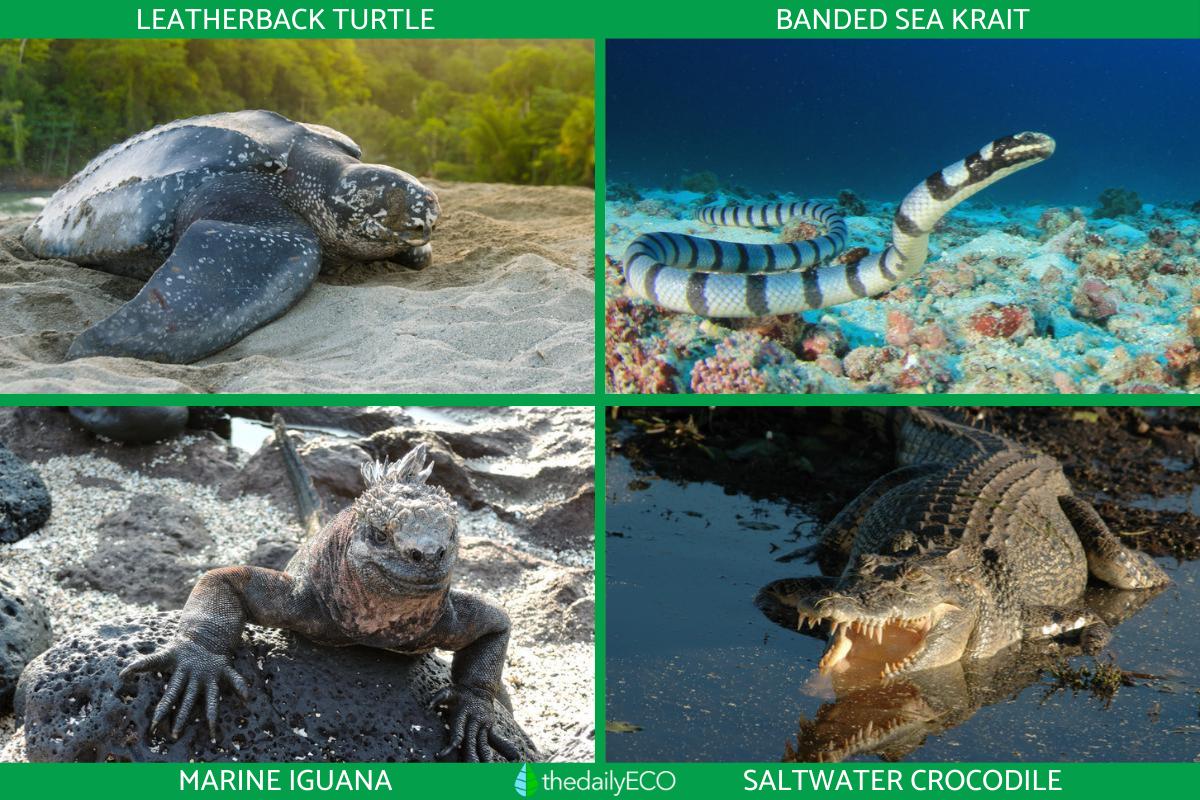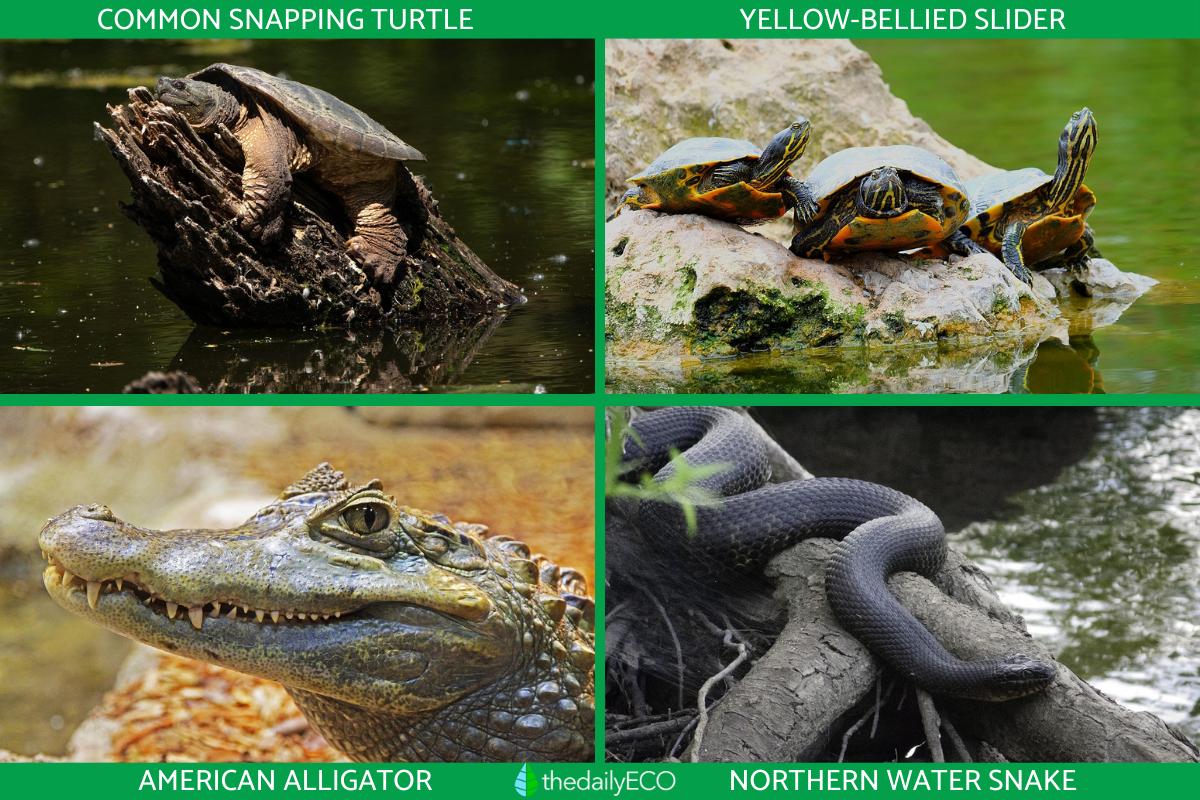Types of Aquatic Reptiles


Aquatic reptiles are reptile species which are adapted to living in freshwater or marine habitats. Some may spend all of their lives in water, but many carry out different behaviors in both terrestrial and aquatic environments. For example, sea turtles are a type of aquatic reptile which normally only venture on to land to lay eggs. Despite having aquatic adaptations, reptiles carry out pulmonary breathing. This means they do not have gills to breathe underwater and need to surface frequently to intake oxygen. Some can reduce their metabolic rate in water, allowing to survive for longer without breathing.
Aquatic reptiles have existed since prehistory, with ichthyosaurs, plesiosaurs, and mosasaurs being some examples of prehistoric aquatic reptiles. In this article from thedailyECO, we look at current freshwater and marine reptile examples with the different types of aquatic reptiles we can find in nature.
What are aquatic reptiles?
Reptiles are animals from four different orders that make up the class Reptilia, excluding the cladistic addition of birds. Some of these are exclusively terrestrial, but many are adapted to living in aquatic environments. Aquatic reptiles are a specialized group which have evolved from their terrestrial ancestors to become morphologically and physiologically adapted to freshwater or marine environments.
The evolutionary transition to aquatic living has resulted in approximately 100 species which have adapted to living in the world's oceans. This includes 7 species of sea turtle and about 80 species of sea snake. However, the majority of aquatic reptiles live in freshwater environments.
There are certain characteristics common to all aquatic reptiles and others which are specific to their type:
- Body temperature: aquatic reptiles are ectothermic, meaning they rely on external temperatures to regulate their body temperature. For this reason, they only live in warm climates such as tropical and subtropical oceans.
- Skin: they have dry and scaly skin that provides protection against dehydration. This is an essential trait for their survival in aquatic habitats, especially saltwater seas where there is a high level of salinity.
- Marine adaptations: many marine species have salt glands that allow them to excrete excess salt, helping to maintain water balance in a marine environment.
- Breathing: they have a flap of tissue covering their nostrils during dives which optimizes their ability to stay underwater. Their lungs can also inflate to increase air retention.
Learn more about types of prehistoric aquatic reptiles with our article asking were there ocean dinosaurs?

How do aquatic reptiles breathe?
As stated in the introduction, no reptile has ever evolved gills to breathe underwater. Their respiratory system is primarily pulmonary, necessitating them to breathe air in order to obtain oxygen. Certain marine mammals can store oxygen in the hemoglobin of their blood and in the myoglobin of their muscles. Aquatic reptiles have different mechanisms for prolonged diving or underwater swimming.
When submerged underwater, aquatic reptiles reduce their metabolic rate. This decreases their overall need for oxygen. Some species can resort to anaerobic pathways to obtain ATP, allowing them to survive without oxygen for an extended period time. Other aquatic reptiles, such as certain species of turtles and snakes, can absorb oxygen directly from the aquatic environment through their skin or mouth cavities.
For example, snakes of the genera Acrochordus (wart snakes) and Cerberus (dog-faced water snakes) can remain submerged for about half an hour, while the green sea turtle (Chelonia mydas) can do so for up to 50 minutes. Sea snakes possess an elongated lung that extends the length of their body, allowing them to store large amounts of oxygen.
Types of marine aquatic reptiles
Although marine reptiles are lesser in terms of number of species, they are often the most well adapted to aquatic life. This is because they often live away from terrestrial areas. Some types of marine reptiles include:
- Sea turtles: these are reptiles belonging to the order Testudines. They have streamlined bodies and limbs transformed into flippers, allowing them to swim efficiently. They are found in all oceans except the polar regions. Their diet ranges from marine plants to invertebrates and fish. The seven species of sea turtles include the leatherback turtle (Dermochelys coriacea). Learn about when is World Turtle Day to learn about their conservation.
- Sea snakes: belonging to the subfamily Hydrophiinae. These are reptiles that are highly adapted to the aquatic environment. With flattened tails that act like paddles, they can remain submerged for long periods. There are 62 species of sea snakes, almost all of which are venomous. They feed mainly on fish and other small marine animals. Sea kraits are the only known sea snake which is also able to move on land.
- Marine iguanas (Amblyrhynchus cristatus): also known as sea iguanas, they are endemic to the Galapagos Islands and are the only completely marine lizard. They feed on macroalgae, diving into the ocean to access their food sources. This distinguishes them from other reptiles. Learn about this species and other types of iguanas in our related guide.
- Saltwater crocodiles: these are the largest marine reptiles, although they are also capable of living in brackish and fresh water. They are carnivorous predators that feed on fish, crustaceans and birds. Although they are considered aquatic reptiles, they rarely venture into the open sea, preferring estuaries and mangroves.
Read more at thedailyECO to discover why the saltwater crocodile is the ultimate apex predator.

Types of freshwater aquatic reptiles
Although there are more freshwater than saltwater aquatic reptiles, they are usually less well adapted to fully aquatic living. This is because they often live between land and freshwater bodies of water, requiring both for survival. This means many of the various types of freshwater reptiles we can find are considered semi-aquatic reptiles:
- Turtles: as with sea turtles, their freshwater relations are from the order Testudines. They are adapted to living in various freshwater habitats, including near lakes, rivers and different types of wetlands. They do not have flippers like sea turtles, but they may have webbed feet to help them maneuver in water. Common types of freshwater turtles include snapping turtles (family Chelydridae) and terrapins (various families).
- Crocodilians: members of the order Crocodilia include crocodiles, alligators, caimans and gharials. Only the saltwater crocodile inhabits marine waters, but even they are adapted to freshwater also. Some species are massive, but they range in size. They use the water to hide, breathing through their nostrils with the rest of their body under water. They are ferocious and skillful predators.
- Snakes: most snakes are terrestrial, but there are also some which are adapted to swimming in freshwater. Unlike sea snakes, they do not tend to be venomous. Instead, they catch their prey in the water. Species include the northern water snake (Nerodia sipedon).
While there are some other species of lizard which can swim, none are considered true freshwater aquatic animals. Learn more about the diversity of these reptiles with our article on the different types of lizards.

Types of prehistoric aquatic reptiles
We have provide examples of the different types of aquatic reptiles which can currently be found in nature. The fossil record shows that there are also many prehistoric reptiles which were supremely well adapted to living in the water. They include the following:
- Ichthyosaurs: emerging in the Triassic Period, these ranged in size from 1 to 26 m. Their morphology resembled a cross between fish and dolphins. Their limbs were fins and their pointed heads were equipped with conical teeth. These reptiles were effective predators in their environment. They also had characteristics such as large eyes for vision at depth and a vertical caudal fin that provided them with powerful propulsion.
- Placodonts: these are also animals that lived during the Triassic period. Their name means ‘tablet teeth’ due to their flat teeth which were adapted to crush mollusks and other prey animals. Their dense skeleton meant they were not very buoyant, suggesting they lived mainly in shallow waters where they fed on marine invertebrates.
- Plesiosaurs: appeared in the Jurassic Period. They are another clade of marine reptile. They had wide bodies, four long fins and two morphological types composed of those with long necks and those with short necks. The latter were agile predators, while the long-necked plesiosaurs captured smaller prey.
- Thalattosuchia: as with Plesiosaurs, they appeared in the Jurassic Period. They include marine crocodiles that evolved during the Early Jurassic. Although they do not belong to the Crocodilia group, they showed adaptations such as fins and smooth skin, which allowed them to inhabit the ocean.
- Mosasaurs: lived in the Late Cretaceous and were similar to monitor lizards (Varanus spp.), but more elongated and streamlined. Adapted to give birth to live young, they were effective predators that used broad tails for propulsion, showing a high degree of specialization in their marine habitat.
Although prehistoric, these marine reptiles were not considered dinosaurs. Learn how many types of dinosaur there were with our related article.
If you want to read similar articles to Types of Aquatic Reptiles, we recommend you visit our Wild animals category.
- Cortés, E. (n.d.). Respiratory system of reptiles and amphibians (Part 2). Veterinary Association of Reptiles and Amphibians.
https://www.veterinariareptilesyanfibios.com/sistema-respiratorio-de-reptiles-y-anfibios-parte-2/ - Motani, R. (2009). The evolution of marine reptiles. Evolution: Education and Outreach, 2(2), 224–235.
https://doi.org/10.1007/s12052-009-0139-y - Rasmussen, A. R., Murphy, J. C., Ompi, M., Gibbons, J. W., & Uetz, P. (2011). Marine reptiles. PLOS ONE, 6(11), e27373.
https://doi.org/10.1371/journal.pone.0027373








